![]()
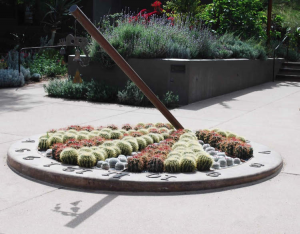
If you stick a pole in the ground in your garden and mark the sun shadow of this pole, you have a sundial for the location of your garden.
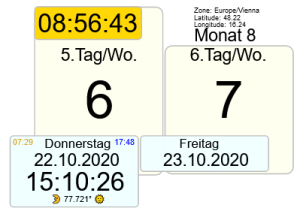 This clock simulates such a sundial in the computer. However, it can do this for any location on earth. A second clock is located in the lower part and shows the time of the respective time zone.
This clock simulates such a sundial in the computer. However, it can do this for any location on earth. A second clock is located in the lower part and shows the time of the respective time zone.
In addition to the time on the sundial(08:56:43) and the time of the time zone (15:10:26), this watch also shows two calendar days. Above the natural lunisolar calendar and below the artificial Gregorian calendar. Sunrise and sunset are also entered in the lower calendar as the time of the respective time zone. On the left the yellow sunrise (07:29) and on the right the blue sunset (17:48).
The two calendar days are slightly shifted from one another because the day on the lower one begins at midnight. The day of the above calendar starts a few hours later at sunrise.
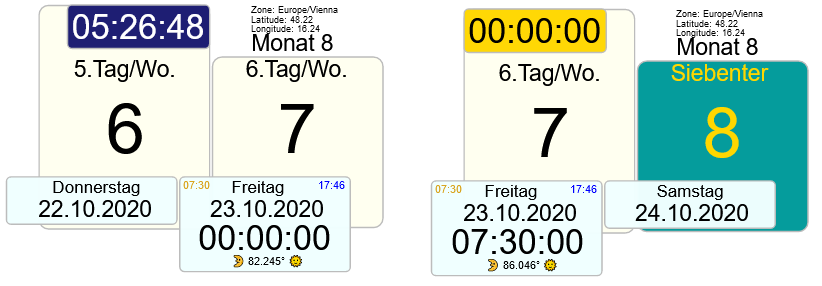
The current day of the lunisolar calendar is always the left day (6th day of the month / 5th day of the week). The right day is the following day. In the lower, Gregorian calendar, the current day switches to the right day from midnight. At sunrise, the entire clock jumps one day to the left.
Time of the sundial
The time of a sundial only coincides with modern clocks at the equinox of spring and autumn, because only then are day and night the same length. In summer, an hour on the sundial is always longer than an hour in modern times. In winter, one hour on the sundial is always shorter.
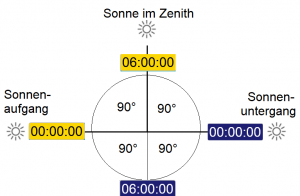 With sundials it is always noon on the 6th hour of the day because the sun is at the zenith of the respective location. Likewise, it is always midnight at the 6th hour of the night. In modern times, the 12th hour is noon. In the modern era, however, the sun is only at its zenith during the equinox.
With sundials it is always noon on the 6th hour of the day because the sun is at the zenith of the respective location. Likewise, it is always midnight at the 6th hour of the night. In modern times, the 12th hour is noon. In the modern era, however, the sun is only at its zenith during the equinox.
This clock can be used to check this easily because it can be started at any location and at any time. You can also jump back and forth every second, minute, hour, day, month and year. Enter the time of any equinox (e.g. March 20th, 2020), after which you will be able to see the same duration of day and night and the approximate synchronicity of both clocks.
Distance from sun to moon
In addition, you can find the distance between the sun and the moon on this watch. With a new moon this is 0 ° and with a full moon 180 °. The waxing crescent is 90 °, the waning crescent is -90 °.

In the picture you can see the distance between the sun and moon one second before the changeover to winter time. A second later, the sunrise is shifted by one hour because the clocks were set back by one hour. The hour that has disappeared can also be recognized by the distance between the sun and the moon.
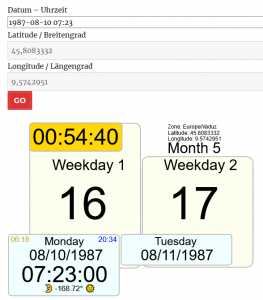 This clock is particularly suitable for determining the exact sundial time of events because it is not the nearest capital of a time zone that determines this time, but the exact longitude and latitude. For example, you can determine the exact local time of a birth, because the sunrise differs from place to place even within a time zone.
This clock is particularly suitable for determining the exact sundial time of events because it is not the nearest capital of a time zone that determines this time, but the exact longitude and latitude. For example, you can determine the exact local time of a birth, because the sunrise differs from place to place even within a time zone.
An example:
Simon was born on August 10th, 1987 at 7:23 am in Milan / Bergamo.
Longitude and latitude from Google Maps browser line: https://www.google.at/maps/place/24030+Mailand,+Bergamo,+Italien/@45.8083332,9.5742951,17z
Time: 1987-08-10 07:23:00
Result: Simon was born on the 16th day of the 5th month, in the daytime at 00:54:40. This is the first day of the 3rd week in the 5th month. The sun rose at 06:18 in Milan / Bergamo that day.
According to the Creator Calendar, Simon’s birthday is on the 16th day of the 5th month. This day rarely coincides with August 10th of the Gregorian calendar.
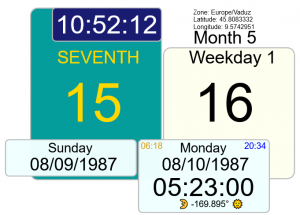 If Simon had been born two hours earlier, he would have been born on the 15th day of the 5th month, during the night at 10:52:12. That would be the 7th day of the 2nd week in the 5th month.
If Simon had been born two hours earlier, he would have been born on the 15th day of the 5th month, during the night at 10:52:12. That would be the 7th day of the 2nd week in the 5th month.
Widget and smartphone version
The widget and smartphone versions of the sundial show the temperature instead of the distance between the sun and moon.
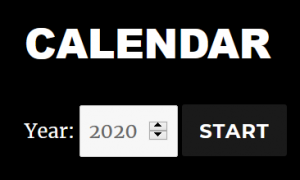 The web app “medianus.at/godclock” is used on the smartphone. The sky calendar is also integrated there. The calendar is activated after clicking START.
The web app “medianus.at/godclock” is used on the smartphone. The sky calendar is also integrated there. The calendar is activated after clicking START.
The calendar can be enlarged and reduced again as required. Since everything is programmed as vector graphics, all details always remain sharp and legible, even with a high magnification.
Depending on the region and city selected, a second sundial is displayed below the calendar.
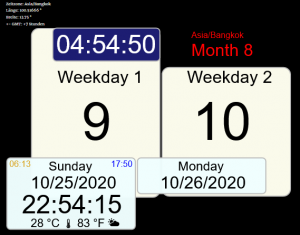 In the example, the region Asia and the city of Bangkok have been selected in the calendar. The second clock, below the calendar, now shows not only the current time in Bangkok, but also the sunrise and sunset, as well as the weather there.
In the example, the region Asia and the city of Bangkok have been selected in the calendar. The second clock, below the calendar, now shows not only the current time in Bangkok, but also the sunrise and sunset, as well as the weather there.
Calendar days of the sky calendar
NEW MOON DAY in the sky calendar
The calendar days of the lunisolar calendar are determined by the moon. A new month begins with every new moon. The NEW MOON DAY always begins on the day after the new moon conjunction. If this conjunction of the sun and moon falls in the daytime hours, the NEW MOON DAY begins the next day. NEW MOON DAY is the 1st day of the month. It is not a weekday, so the 1st day of the 1st week always begins after NEW MOON DAY. This means that this day is always the 2nd day of the month.
The SEVENTH in the sky calendar
On the 7th day of each week the moon is always very close to half, full or new moon. This means that this calendar can be roughly read from the phases of the moon. In the Bible the 7th day is called the Sabbath, which translated means the SEVENTH day.
The SEVENTH of every month is the 8th day (~ increasing crescent moon), the 15th day (~ full moon), the 22nd day (~ decreasing crescent moon) and the 29th day (~ new moon).
The SEVENTH of the 4th week is not always followed by the new moon day of the next month. There is often a 30th day of the month, which is also not a weekday.
The beginning of the year in the sky calendar
The beginning of the year is first determined by the sun, then the moon takes over again. First comes the equinox of spring. The new moon that follows is the beginning of the new year.
The year does not always end after 12 months. Every few years a 13th month arises by itself. Because this 13th month comes about by itself, just as there is a 30th day of the month every few months, this calendar does not need any artificial switching elements.